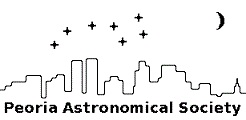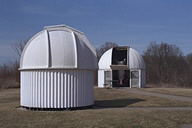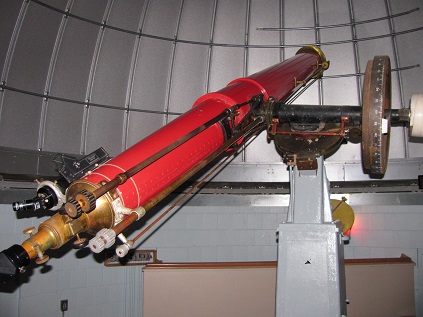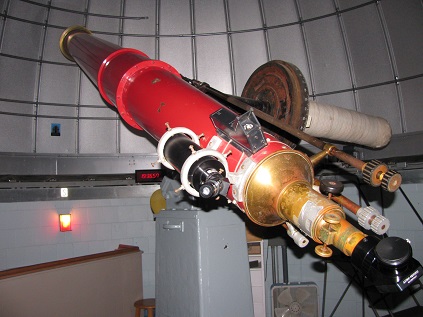 |
Current sky conditions for Peoria, IL:
|
Observatories
The Peoria Astronomical Society maintains two observatories.
The Decker-Grebner-Van Zandt Observatory (Map, Location)

The Decker-Grebner-Van Zandt Observatory, otherwise known as "Jubilee" observatory, was built on the grounds of Jubilee State Park in an effort to escape the Peoria city lights. Over the years however, the city has been growing ever closer, and obscuring the night sky with light pollution.
The observatory has two domes that house a 24-inch Newtonian Reflector and a 14-inch Schmidt-Cassegrain.
The site was established in 1974, when PAS member Dr. Philip Holwick offered to donate his 12-inch Cave reflecting telescope to the Society on the condition that a suitable "dark-site" could be found for it. PAS members located an abandoned farmyard complete with several out buildings and a large concrete feedlot. The land was owned by the Forest Park Foundation, and use was granted for the PAS to develop an observatory. Mr William Rutherford of Forest Park Foundation not only granted the use of the land but also authorized funds to help the PAS develop the site.
The 10-foot dome (foreground) had been built originally in the 1960's as one of the first fiberglass domes in the country. It was originally located at the Northmoor Observatory, but had fallen into disrepair and disuse because of the growing light pollution problem on the city's north side. Because of the problems in setting up the 14-inch telescope, the dome was moved, repaired, and re-installed to house the 14-inch telescope at the Jubilee site.
In 1976, Dr. Sam Decker offered to purchase a 16-inch telescope and donate it to the Society. Society members Art Grebner and Rollin Van Zandt responded to Dr. Decker's offer by asking if he would be willing to donate the money to the club instead and let the PAS build as large a telescope as possible.

Dr. Decker agreed, and work began on building the 24-inch Newtonian. The PAS bought a 24-inch Pyrex mirror blank and a 5-inch elipitcal flat. Art Grebner undertook the job of grinding the mirror, while Rollin Van Zandt began construction of the tube assembly and a horse-shoe mount. It took Art Grebner 6 months to complete the mirror grinding, sometimes resorting to power tools to remove the enormous amounts of glass. Rollin Van Zandt's task took over two years to complete.
Art Grebner had built a dome outside his country home, but when he decided to move to the city, he had to do something with the dome, realizing the PAS needed it more than he did, he tore it down, and piece by piece reassembled it at Jubilee. Scott Swords, also a PAS member, donated the use of several pieces of earth moving equipment so that eroded areas could be filled in and the hill top leveled. The area was seeded with blue grass and buffalo grass to control insects and erosion.
Finally in 1980, under police escort from Peoria, the 24-inch telescope was moved on its mount to Jubilee. In 1981, the original DC motors for controlling the telescope were replaced with stepper motors and encoders were added in preparation for adding the computer to control the movements of the telescope.
Building the Decker-Grebner-Van Zandt Observatory and its telescopes have cost the Society in the vicinity of 10,000 man-hours. There is still more work to be done! The history doesn't end here...it begins...
Click Here to read about the current Jubilee renovations!
Northmoor Observatory (Map, Location)
 Northmoor Observatory is located within the city of Peoria at Donovan Park (formerly Leo Donovan Golf Course), and houses a 9 inch refractor telescope.
Northmoor Observatory is located within the city of Peoria at Donovan Park (formerly Leo Donovan Golf Course), and houses a 9 inch refractor telescope.
 The telescope was one of two built in 1913 for the Illinois Watch Company of Springfield, Illinois.
The 9-inch flint-forward lens was ground by Petitdidier, the same optician who ground lenses for Dr. A.A. Michelson's famous experiment to determine the speed of light.
The telescope body was manufactured by Gaertner Scientific of Chicago, Illinois.
The telescope was purchased by Bradley University, but put away and never used.
It was later "re-discovered" sitting under bleachers in Huff Gym in the old Field House on the Bradley campus.
In 1955, it was reassembled at the Northmoor site where it still stands.
The observatory underwent a major renovation in 2009, and a new rotating dome was installed in place of the original rusted dome.
The telescope was one of two built in 1913 for the Illinois Watch Company of Springfield, Illinois.
The 9-inch flint-forward lens was ground by Petitdidier, the same optician who ground lenses for Dr. A.A. Michelson's famous experiment to determine the speed of light.
The telescope body was manufactured by Gaertner Scientific of Chicago, Illinois.
The telescope was purchased by Bradley University, but put away and never used.
It was later "re-discovered" sitting under bleachers in Huff Gym in the old Field House on the Bradley campus.
In 1955, it was reassembled at the Northmoor site where it still stands.
The observatory underwent a major renovation in 2009, and a new rotating dome was installed in place of the original rusted dome.
 Northmoor Observatory provides excellent views of stars, planets, and our moon. It was the first observatory in Illinois to offer public viewing, and the PAS continues to provide this service to the community today.
Northmoor Observatory provides excellent views of stars, planets, and our moon. It was the first observatory in Illinois to offer public viewing, and the PAS continues to provide this service to the community today.
The observatory is open to the public every cloudless Saturday night from the beginning of May through the end of October. You will find volunteers on hand to aid you in your discovery of the cosmos, from sunset until midnight.
The Observatory and telescope are maintained by the PAS with the help of generous donations of members of the Peoria community.
Click Here to read about the 2009 Northmoor Renovations!
NorthMoor Observatory - 50 Years and Beyond
The History:
- The lens for the 9-inch refractor at NorthMoor was ground by Pettididier, who also ground the lens used by scientist A.A. Michelson in his experiments to determine the speed of light.
- The telescope was built in Chicago (1913) for the Illinois Watch Company and is considered an antique by astronomers at Yerkes Observatory, home of the world's largest refractor.
- The NorthMoor Observatory, constructed through the efforts of the Peoria Academy of Sciences, the Park District, and numerous corporations, was dedicated on July 23, 1955.
- Clyde Tombaugh, discoverer of the planet Pluto, came to the NorthMoor Observatory in 1982 and observed through the famous refractor.
- Several hundred people came to NorthMoor Observatory in 1994 to view the dark spots left on Jupiter after the Comet Shoemaker-Levy crashed.
- Thousands came to the PAS viewing sessions to see the solar eclipse of 1994 and comets Halley (1986), Hyakutake (1996), and Hale-Bopp (1997).
- Thousands came to view Mars, the week of August 2003, when the planet came closer to Earth than it has been in 60,000 years.
The Peoria Astronomical Society's Mission:
The members of the Peoria Astronomical Society could be content with bringing their private telescopes to our dark sky observatory near Jubilee State Park, or with observing through the society's telescopes there. However, we are committed to bringing astronomy to where the people are and where they can conveniently observe the Moon, planets, stars, and comets. Our public education program consists of:
- Public viewing sessions, conducted at Northmoor Observatory every Saturday night from the beginning of May to the end of October (weather permitting).
- Special public viewing sessions, arranged for special events at NorthMoor or at other locations more appropriate for the type of event.
- Private group educational sessions, presented by the PAS at NorthMoor Observatory and at various off-site locations.
The Numbers:
50 - The number of years the Peoria Astronomical Society has conducted public viewing sessions at NorthMoor Observatory.
1,400 - The number of Saturday night viewing sessions at the NorthMoor Observatory conducted by members of the PAS.
45,000 - The number of people who have looked through the 9-inch refractor at the NorthMoor Observatory.
7,000 - The total man-hours volunteered by PAS members at the Saturday night viewing sessions at the NorthMoor Observatory.
$110,000 - A conservative value of the PAS contribution in man-hours toward the Peoria Park District in conducting the Saturday night viewing sessions.
From the 1964 PAS Newsletter...
"After the Park Board approved the transaction for the site of our observatory, the scope-less sky-scanners (the Astronomy Section members) were ready to move. With the completion of the plans on June 24, 1953, groundbreaking at NorthMoor Golf Course took place the following autumn."
"The combined building cost was $11,500. Because of membership cooperation as well as that of various business firms, we eluded a building estimate of $50,000 - the 1964 cost of total replacement. In addition to the building value, this replacement value of the refractor is $15,000 [1964 dollars] - thus making the cost of replacement or duplication $65,000 [1964 dollars]."
"Due to the efforts of a group of Caterpillar specialists, the new observatory was well equipped. Mr. Van Zandt undertook the construction of a drive to rotate the dome. Dr. Ernest Landen devised the clock drive that powered the telescope. The scope's drive was synchronized with the pendulum mechanism he built in the lecture room which was completed in November, 1956; at a cost of $5,500."
The Future:
The Peoria Astronomical Society is committed to continuing the long tradition of providing a view of the night skies to the public. The new new dome is installed, and renovations to the warm-up room are complete!
If you would like to donate to the PAS for the NorthMoor Observatory restoration project, please send your check or money order to the following address:
Peoria Astronomical Society
PO Box 10111
Peoria, IL 61612-0111
For additional information, please contact us.